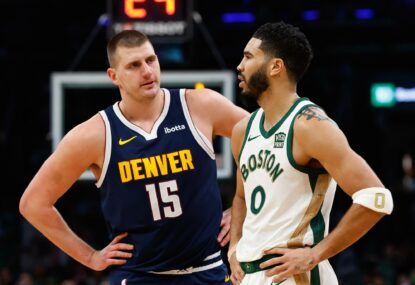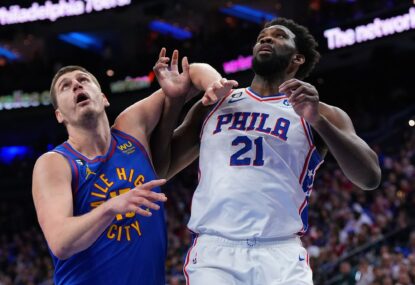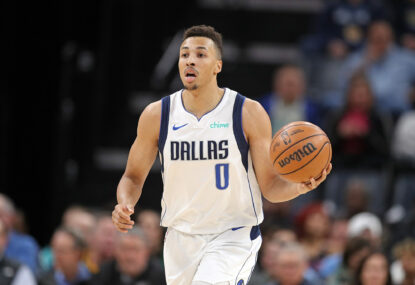Talent is important in the NBA, but geometry is decisive.
The rise of the pick and roll as the pre-eminent basketball play and the now religious adherence to spacing and the three-point shot has created a league where geometry reigns.
Just look at the LA Clippers prospering without their most talented player.
Blake Griffin is one of the ten best basketball players on Earth but he makes for an awkward fit next to DeAndre Jordan, loading the frontcourt with two players who don’t stretch out to the three-point line.
With Griffin out of the picture the Clippers have barely missed a beat (so far), replacing his diverse skillset with something much simpler but also more ‘modern’ and powerful in its own right: surround a Chris Paul/Jordan pick and roll with three shooters and good things will come.
It won’t get the attention that sun-soaked glitzy Los Angeles attracts, but there’s another geometry project taking place in cold desolate Detroit.
Coach Stan Van Gundy will be the first one to let you know a fact that you’re probably unaware of: in the five years prior to his arrival no team in the East won fewer games than the Detroit Pistons.
Between the Bad Boys and the Billups Boys, the Pistons quietly became an institution of NBA success. Only the Lakers, Spurs, Bulls and Heat can match their three titles since 1986.
But a run of eight consecutive playoff appearances from 2002 to 2009, with six consecutive conference finals appearances in the middle of that run, came to a screeching halt in the 2009-10 season.
The 2004 championship core got old and Joe Dumars, once the king of the hit or miss transaction, became the dunce of transactions that just missed all the time. Bring up the names Charlie Villanueva or Ben Gordon and tears stream down the faces of grown men in Michigan.
The five lost years of post-Billups pre-Stan Van were defined by ill-conceived free agent signings (I’m yet to meet the human or sentient animal who thought playing Josh Smith at small forward alongside Greg Monroe and Andre Drummond was a recipe for anything other than flaming faeces served with sides of discontent), bad coaching hires (we all have fond memories of the John Kuester era) and a general commitment to mediocrity.
Those Pistons teams were awkward collections of ‘meh’ basketball players, such as Rodney Stuckey, Kyle Singler and Jonas Jerebko, too good to get you a top three draft pick and too bad to give meaning to your basketball existence. The malaise was palpable.
Enter SVG. Since his arrival prior to last season, Van Gundy has stripped Detroit down to its bare parts and then rebuilt it into something that resembled competence and is now approaching true relevance, and might be on the path to something special. He kicked Josh Smith to the curb, wisely let Greg Monroe walk in free agency, and parlayed a heap of nothing into a borderline All-Star point guard.
Brandon Jennings, a back-up point guard coming off a serious injury, and Ersan Ilyasova, an effective placeholder obtained for another heap of nothing, were turned into a 23-year-old with All-Star upside on a four-year contract handed out in the pre-explosion salary cap. In Reggie Jackson and Tobias Harris, SVG has landed two foundational pieces.
The one thing the Pistons did well in the final Dark Days of Dumars was find players in the first round of the draft. It went against form, because when the Pistons were dominating the Eastern conference Dumars couldn’t find upper echelon talent in the draft to save his life.
The infamous decision to take Darko Milicic over Carmelo Anthony, Chris Bosh and Dwyane Wade in 2003 kicked off an inglorious run which saw the following players as Detroit’s top draft picks from 2004 to 2009: Rickey Paulding, Jason Maxiell, Will Blalock, DJ White and Austin Daye. Those names are the greatest reason for Detroit’s subsequent seasons in the NBA abyss.
After ’09 though, Dumars drafted the following four players at picks 7, 8 or 9 in the draft: Monroe, Brandon Knight, Andre Drummond and Kentavious Caldwell-Pope. All those players have delivered on their draft positions, even if Monroe ultimately delivered for nothing (Knight is no longer with Detroit either but he turned into Jennings who turned into Harris).
In Jackson, Harris, Drummond, Caldwell-Pope, and Van Gundy’s lone first round pick to date Stanley Johnson, the Pistons have the best Under-26 core in the East (admit it, Orlando and Milwaukee fans, admit it). More impressive than the raw collection of talent is the fact that this team just makes sense. The geometry works.
In Orlando, SVG had a simple roster construction premise that propelled his team to the Finals: spread the floor with shooters around a pick and roll featuring an above-average point guard and a dominant rolling big man who could also anchor an elite defence.
He’s doing the same thing now in Detroit. The Pistons’ biggest problem is that Andre Drummond is not Dwight Howard, but he may not need to be – the Detroit supporting cast should be better than Orlando’s.
Where this team’s true devastating potential lies is on defence. In Caldwell-Pope, Johnson, Harris and Drummond the Pistons have length, bounce and athleticism everywhere, a switching nightmare for opponents. Strong enough to hold their ground, long enough to disrupt passing and driving lanes, and fast enough to wreak havoc in transition. They’re already a top ten team in defensive efficiency (admittedly, they are tenth).
Detroit’s ability to become a championship contender will likely depend on their ability to craft an elite offence. There is potential everywhere but just as many question marks.
The Orlando blueprint was heavily dependent on outside shooting and right now Detroit only have outside shooting in theory. Caldwell-Pope, Johnson and Marcus Morris are all shooting under 32 per cent from deep this year and Harris is a career 32 per cent shooter from three.
Jackson is a vastly improved shooter, sniffing 38 per cent this season, but he’s a career 31.7 per cent marksman from downtown. We need a bigger sample size to know if his improvement is real – if it’s not, that’s a problem, because Jackson’s ability to punish teams from going under the pick and roll is decisive for Detroit’s offence.
Despite the doubts, the upside is tremendous. Unlike the Bucks, for whom improved shooting is only a blind hope, the Pistons young guns have solid shooting form and the platform to become respectable shooters. Shooting will only round out their exciting skill sets: Harris is a versatile threat who can do a bit of everything, Jackson is a dynamic pick and roll point guard, and Caldwell-Pope and Johnson are perfect complements to their ball-needy teammates.
The Pistons are above .500, seemingly ahead of schedule in the Van Gundy rebuild. They should make the playoffs but it doesn’t really matter. The February trades for Jackson and Harris the past two seasons have signalled that Van Gundy is looking towards the future at the expense of ultimately meaningless present results. It’s a wise move, and as a consequence the future is bright.
SVG hasn’t been perfect in Detroit. The signings of Jodie Meeks, Caron Butler and Aron Baynes (sorry, Australia) were ill-conceived, as was the financial manner in which Josh Smith was deposed.
The voided Donatas Motiejunas trade was also a godsend for Detroit, who somehow decided it was worth giving up a middle of the first round draft pick (in the last draft before the cap explosion) for an unproven big man with back issues about to hit free agency.
But no-one bats 1000 and SVG has had far more hits than misses. After half a decade of almost entirely misses, that’s something to put your hands up for – especially in that city.


































































































